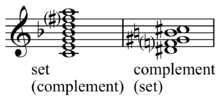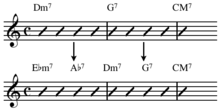Outside (jazz): Difference between revisions
Tags: Reverted Visual edit |
|||
| (3 intermediate revisions by 3 users not shown) | |||
| Line 1: | Line 1: | ||
{{Short description|Improvisational approach}} |
{{Short description|Improvisational approach}} |
||
| ⚫ | In [[jazz]] [[musical improvisation|improvisation]], '''outside playing''' describes approaches where one plays over a scale, mode or chord that is harmonically distant from the given [[chord (music)|chord]]. There are several common techniques to playing outside, that include side-stepping or side-slipping, superimposition of [[Coltrane changes]],<ref>{{cite book |last=Porter |first=Lewis |title= John Coltrane: His Life and Music |page=225 |location=Ann Arbor |publisher=The University of Michigan Press }}</ref> and [[polytonality]].<ref name= "Liebman">{{Cite thesis |last=Vashlishan |first=M |title=THE ORIGINS OF DAVID LIEBMAN'S APPROACH TO JAZZ IMPROVISATION |url=http://daveliebman.com/Feature_Articles/MattThesis.pdf |publisher=William Paterson University |access-date=2014-01-27 }}</ref> |
||
| ⚫ | The term '''outside''' is commonly used by jazz musicians playing in a post-bop idiom, but despite its frequent use in musicians’ jargon there is no set or standardized definition for it. As the term is commonly understood, outside is not a direct synonym to terms such as [[free improvisation]], [[polytonality]] or [[atonality]] but a musical phenomenon in its own right. Also, outside concerns tonal tension; it does not involve breaking rhythmic, timbral or stylistic boundaries. Certain performance characteristics are as central in outside playing as they are in jazz improvisation in general: playing with good sound; with rhythmic drive and stability; and with confidence and conviction. |
||
== Inside - outside - inside == |
|||
According to a study on how the outside concept is constructed, outside is a method for improvisation which consists of three steps<ref>{{Cite web |last=Erlandsson |first=Fredrik |date=2022-12-09 |title=“What Is the Basic Rule of Outside”? : The Construction of a Jazz Improvisation Concept in On-line Environments |url=https://www.doria.fi/handle/10024/186212 |access-date=2023-02-14 |website=www.doria.fi}}</ref>. These steps correlate with the formula inside – outside – inside, and with how Western harmony is often understood: consonance – dissonance – consonance. |
|||
The first step is the establishment of a sense of inside. This does not necessarily have to mean emphasized playing in one clearly stated tonality or to avoid chromatics, but rather to set a stylistic and idiomatic norm for the solo, or to simply follow the rules of chord/scale theory. This is done by outlining the chord progressions and by choosing notes in accordance with the chord/scale concept. |
|||
The second step is to disregard the common rules of jazz harmony and play to outside of the harmonic framework. This means choosing notes that have no or very little harmonic connection to the notes prescribed by the chord/scale concept. As the notes in the solo line clash against the chords, the result is tension. |
|||
Finally, the third step is to resolve the outside lines back inside. Instead of playing notes that are harmonically distant from the chord for the rest of the solo, or just stopping the solo line altogether, thus leaving the outside phrases unresolved, the line is brought back to a close with a sense of a tonal home, that was established in step one. |
|||
The result of going through these steps is that contrast between tension/release is created in a manner that gives structure to the performance. This inside-outside-inside formula is in a way the essence of the method of playing outside. Outside is a contrast to inside, which in turn is a synonym to a way of improvisation that follows the chord-scale system. In other words, outside is a technique for breaking the rules of chord-scale theory. Thus, the idea of outside can only exist in relationship with a discourse of Western harmony and Western principles of music. |
|||
[[File:Side-slipping complementation.png|thumb|right|Side-slipping [[Complement (music)#Aggregate complementation|complementation]]: [[dominant seventh chord|C7 chord]]/[[Lydian dominant scale]] ([[chord-scale system]]) and complement {{audio|Side-slipping complementation.mid|Play}}.]] |
[[File:Side-slipping complementation.png|thumb|right|Side-slipping [[Complement (music)#Aggregate complementation|complementation]]: [[dominant seventh chord|C7 chord]]/[[Lydian dominant scale]] ([[chord-scale system]]) and complement {{audio|Side-slipping complementation.mid|Play}}.]] |
||
[[File:Side-slipping on rhythm changes B section.png|thumb|right|330px|Side-slipping on [[rhythm changes]] B section, written for a B-flat instrument {{audio|Side-slipping on rhythm changes B section.mid|Play}}.]] |
[[File:Side-slipping on rhythm changes B section.png|thumb|right|330px|Side-slipping on [[rhythm changes]] B section, written for a B-flat instrument {{audio|Side-slipping on rhythm changes B section.mid|Play}}.]] |
||
[[File:Side-slipping through distant ii-V.png|thumb|right|Side-slipping through distant ii–V {{audio|Side-slipping through distant ii-V.mid|Play}}.]] |
[[File:Side-slipping through distant ii-V.png|thumb|right|Side-slipping through distant ii–V {{audio|Side-slipping through distant ii-V.mid|Play}}.]] |
||
| ⚫ | The term '''outside''' is commonly used by jazz musicians playing in a post-bop idiom, but despite its frequent use in musicians’ jargon there is no set or standardized definition for it. As the term is commonly understood, outside is not a direct synonym to terms such as [[free improvisation]], [[polytonality]] or [[atonality]] but a musical phenomenon in its own right. Also, outside concerns tonal tension; it does not involve breaking rhythmic, timbral or stylistic boundaries. Certain performance characteristics are as central in outside playing as they are in jazz improvisation in general: playing with good sound; with rhythmic drive and stability; and with confidence and conviction. |
||
| ⚫ | In [[jazz]] [[musical improvisation|improvisation]], '''outside playing''' describes approaches where one plays over a scale, mode or chord that is harmonically distant from the given [[chord (music)|chord]]. There are several common techniques to playing outside, that include side-stepping or side-slipping, superimposition of [[Coltrane changes]],<ref>{{cite book |last=Porter |first=Lewis |title= John Coltrane: His Life and Music |page=225 |location=Ann Arbor |publisher=The University of Michigan Press }}</ref> and [[polytonality]].<ref name= "Liebman">{{Cite thesis |last=Vashlishan |first=M |title=THE ORIGINS OF DAVID LIEBMAN'S APPROACH TO JAZZ IMPROVISATION |url=http://daveliebman.com/Feature_Articles/MattThesis.pdf |publisher=William |
||
==Side-slipping== |
==Side-slipping== |
||
| Line 28: | Line 15: | ||
*[[Coltrane changes]] |
*[[Coltrane changes]] |
||
*[[Polytonality]] |
*[[Polytonality]] |
||
*[[Nonchord tone]] |
|||
==Sources== |
==Sources== |
||
Latest revision as of 22:21, 14 December 2023
In jazz improvisation, outside playing describes approaches where one plays over a scale, mode or chord that is harmonically distant from the given chord. There are several common techniques to playing outside, that include side-stepping or side-slipping, superimposition of Coltrane changes,[1] and polytonality.[2]



The term outside is commonly used by jazz musicians playing in a post-bop idiom, but despite its frequent use in musicians’ jargon there is no set or standardized definition for it. As the term is commonly understood, outside is not a direct synonym to terms such as free improvisation, polytonality or atonality but a musical phenomenon in its own right. Also, outside concerns tonal tension; it does not involve breaking rhythmic, timbral or stylistic boundaries. Certain performance characteristics are as central in outside playing as they are in jazz improvisation in general: playing with good sound; with rhythmic drive and stability; and with confidence and conviction.
Side-slipping
[edit]The term side-slipping or side-stepping has been used to describe several similar yet distinct methods of playing outside. In one version, one plays only the five "'wrong'" non-scale notes for the given chord and none of the seven scale or three to four chord tones, given that there are twelve notes in the equal tempered scale and heptatonic scales are generally used.[3] Another technique described as sideslipping is the addition of distant ii–V relationships, such as a half-step above the original ii–V. This increases chromatic tension as it first moves away and then towards the tonic.[4] Lastly, side-slipping can be described as playing in a scale a half-step above or below a given chord, before resolving, creating tension and release.[2]
See also
[edit]Sources
[edit]- ^ Porter, Lewis. John Coltrane: His Life and Music. Ann Arbor: The University of Michigan Press. p. 225.
- ^ a b Vashlishan, M. THE ORIGINS OF DAVID LIEBMAN'S APPROACH TO JAZZ IMPROVISATION (PDF) (Thesis). William Paterson University. Retrieved 2014-01-27.
- ^ Coker, Jerry (1997). Elements of the Jazz Language for the Developing Improvisor, p.83. ISBN 1-57623-875-X.
- ^ Lawn, Richard; Hellmer, Jeffrey L. (1996). Jazz: Theory and Practice. Alfred Publishing Co., Inc. p. 119. ISBN 0-88284-722-8.
